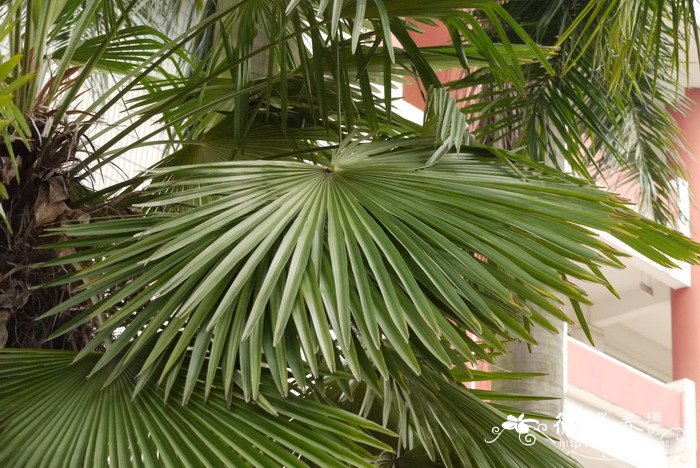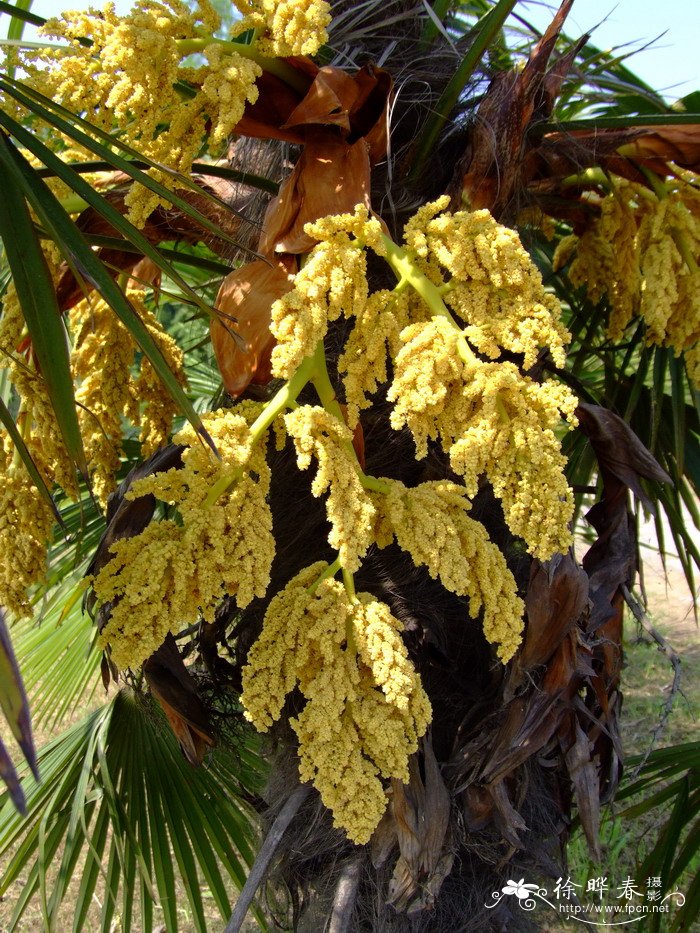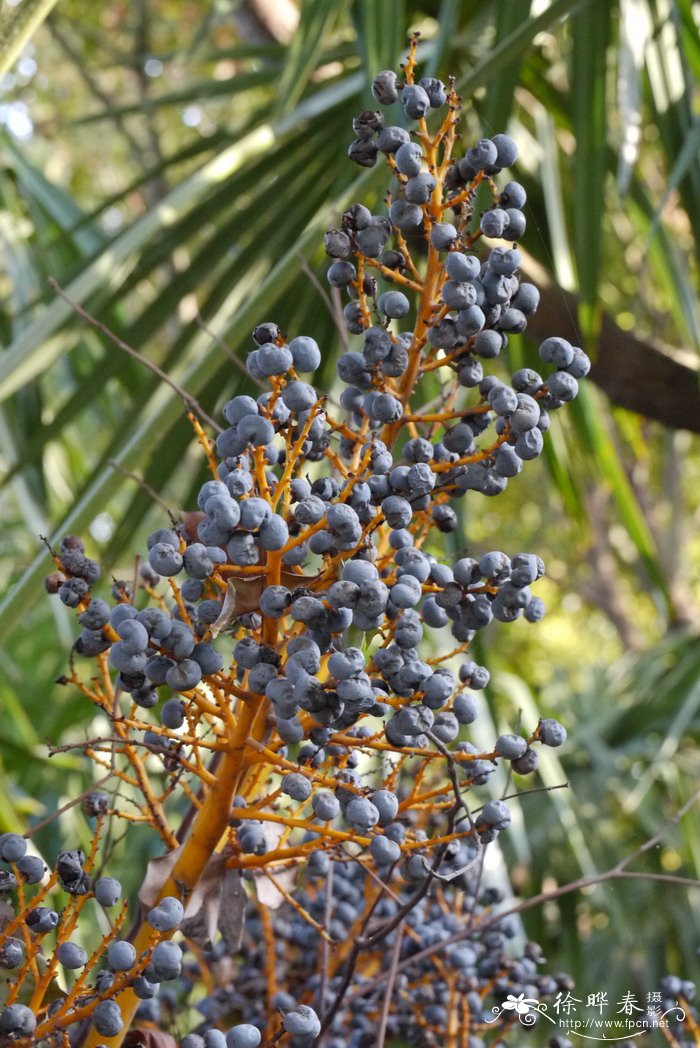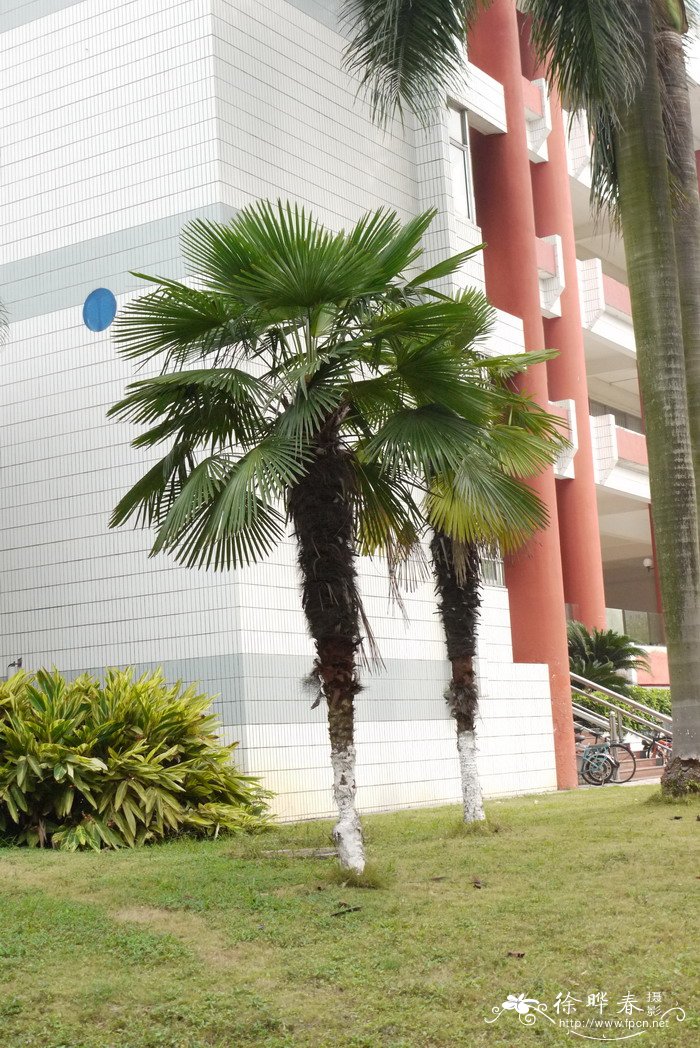棕榈 Trachycarpus fortunei
中文名(Chinese Name):棕榈
学名(Scientific Name):Trachycarpus fortunei (Hook.) H. Wendl.
英文名(English Common Name):Chinese windmill palm
别名(Chinese Common Name):棕树
异名(Synonym):Chaemaerops fortunei Hook Trachycarpus caespitosus Becc. Trachycarpus wagnerianus Becc. Chamaerops fortunei Hook.
科属(Family & Genus):棕榈科(Palmae)棕榈属
形态特征(Description):乔木状,高3-10米或更高,树干圆柱形,被不易脱落的老叶柄基部和密集的网状纤维,除非人工剥除,否则不能自行脱落,裸露树干直径10-15厘米甚至更粗。叶片呈3/4圆形或者近圆形,深裂成30-50片具皱折的线状剑形,宽约2.5-4厘米,长60-70厘米的裂片,裂片先端具短2裂或2齿,硬挺甚至顶端下垂;叶柄长75-80厘米或甚至更长,两侧具细圆齿,顶端有明显的戟突。花序粗壮,多次分枝,从叶腋抽出,通常是雌雄异株。雄花序长约40厘米,具有2-3个分枝花序,下部的分枝花序长15-17厘米,一般只二回分枝;雄花无梗,每2-3朵密集着生于小穗轴上,也有单生的;黄绿色,卵球形,钝三棱;花萼3片,卵状急尖,几分离,花冠约2倍长于花萼,花瓣阔卵形,雄蕊6枚,花药卵状箭头形;雌花序长80-90厘米,花序梗长约40厘米,其上有3个佛焰苞包着,具4-5个圆锥状的分枝花序,下部的分枝花序长约35厘米,2-3回分枝;雌花淡绿色,通常2-3朵聚生;花无梗,球形,着生于短瘤突上,萼片阔卵形,3裂,基部合生,花瓣卵状近圆形,长于萼片1/3,退化雄蕊6枚,心皮被银色毛。果实阔肾形,有脐,宽11-12毫米,高7-9毫米,成熟时由黄色变为淡蓝色,有白粉,柱头残留在侧面附近。种子胚乳均匀,角质,胚侧生。花期4月,果期12月。
分布(Distribution):分布于长江以南各省区,罕见野生于疏林中,海拔上限2000米左右。日本也有分布。
用途(Use):本种在南方各地广泛栽培,主要剥取其棕皮纤维(叶鞘纤维),作绳索,编蓑衣、棕绷、地毡,制刷子和作沙发的填充料等;嫩叶经漂白可制扇和草帽;未开放的花苞又称“棕鱼”,可供食用;棕皮及叶柄(棕板)煅炭入药有止血作用,果实、叶、花、根等亦入药;此外,棕榈树形优美,也是庭园绿化的优良树种。
引自中国植物志英文版:FOC Vol. 23 Page 145
Trachycarpus fortunei (Hooker) H. Wendland, Bull. Soc. Bot. France. 8: 429. 1862.
棕榈 zong lü| Arecaceae | Trachycarpus
Chamaerops fortunei Hooker, Bot. Mag. 86: t. 5221. 1860; C. excelsa Thunberg; Trachycarpus caespitosus Beccari; T. wagnerianus Beccari.
Stem solitary, to 12 m tall, to 15 cm in diam. Leaf sheath fibers persistent, forming an ocrea more than 25 cm; petioles to 60 m, margins with very fine teeth; blades semicircular in outline, to 1.2 m wide, green on abaxial surface, divided to ca. 3/4 their length into 40-50 stiff segments, transverse veinlets barely visible; middle segments to 3 cm wide. Inflorescences 0.7-0.9 m, erect; male inflorescences branched to 4 orders; rachillae 1-3 cm; female inflorescences branched to 3 orders; rachillae 3-15 cm. Fruits black with a waxy bloom, kidney-shaped, to 0.9 × 1.4 cm.
Commonly cultivated, rarely found in forests; 100-2400 m. S of Qin Ling and Chang Jiang [Bhutan, India, Myanmar, Nepal, Vietnam].
Fibers are collected from the leaf bases and made into coats and other items (brooms, brushes, doormats); wax is collected from the fruits; and a hemostatic drug is extracted from the seeds. This species is widely cultivated as an ornamental, especially in cooler climates.



 (责任编辑:徐晔春)
(责任编辑:徐晔春)
学名(Scientific Name):Trachycarpus fortunei (Hook.) H. Wendl.
英文名(English Common Name):Chinese windmill palm
别名(Chinese Common Name):棕树
异名(Synonym):Chaemaerops fortunei Hook Trachycarpus caespitosus Becc. Trachycarpus wagnerianus Becc. Chamaerops fortunei Hook.
科属(Family & Genus):棕榈科(Palmae)棕榈属
形态特征(Description):乔木状,高3-10米或更高,树干圆柱形,被不易脱落的老叶柄基部和密集的网状纤维,除非人工剥除,否则不能自行脱落,裸露树干直径10-15厘米甚至更粗。叶片呈3/4圆形或者近圆形,深裂成30-50片具皱折的线状剑形,宽约2.5-4厘米,长60-70厘米的裂片,裂片先端具短2裂或2齿,硬挺甚至顶端下垂;叶柄长75-80厘米或甚至更长,两侧具细圆齿,顶端有明显的戟突。花序粗壮,多次分枝,从叶腋抽出,通常是雌雄异株。雄花序长约40厘米,具有2-3个分枝花序,下部的分枝花序长15-17厘米,一般只二回分枝;雄花无梗,每2-3朵密集着生于小穗轴上,也有单生的;黄绿色,卵球形,钝三棱;花萼3片,卵状急尖,几分离,花冠约2倍长于花萼,花瓣阔卵形,雄蕊6枚,花药卵状箭头形;雌花序长80-90厘米,花序梗长约40厘米,其上有3个佛焰苞包着,具4-5个圆锥状的分枝花序,下部的分枝花序长约35厘米,2-3回分枝;雌花淡绿色,通常2-3朵聚生;花无梗,球形,着生于短瘤突上,萼片阔卵形,3裂,基部合生,花瓣卵状近圆形,长于萼片1/3,退化雄蕊6枚,心皮被银色毛。果实阔肾形,有脐,宽11-12毫米,高7-9毫米,成熟时由黄色变为淡蓝色,有白粉,柱头残留在侧面附近。种子胚乳均匀,角质,胚侧生。花期4月,果期12月。
分布(Distribution):分布于长江以南各省区,罕见野生于疏林中,海拔上限2000米左右。日本也有分布。
用途(Use):本种在南方各地广泛栽培,主要剥取其棕皮纤维(叶鞘纤维),作绳索,编蓑衣、棕绷、地毡,制刷子和作沙发的填充料等;嫩叶经漂白可制扇和草帽;未开放的花苞又称“棕鱼”,可供食用;棕皮及叶柄(棕板)煅炭入药有止血作用,果实、叶、花、根等亦入药;此外,棕榈树形优美,也是庭园绿化的优良树种。
引自中国植物志英文版:FOC Vol. 23 Page 145
Trachycarpus fortunei (Hooker) H. Wendland, Bull. Soc. Bot. France. 8: 429. 1862.
棕榈 zong lü| Arecaceae | Trachycarpus
Chamaerops fortunei Hooker, Bot. Mag. 86: t. 5221. 1860; C. excelsa Thunberg; Trachycarpus caespitosus Beccari; T. wagnerianus Beccari.
Stem solitary, to 12 m tall, to 15 cm in diam. Leaf sheath fibers persistent, forming an ocrea more than 25 cm; petioles to 60 m, margins with very fine teeth; blades semicircular in outline, to 1.2 m wide, green on abaxial surface, divided to ca. 3/4 their length into 40-50 stiff segments, transverse veinlets barely visible; middle segments to 3 cm wide. Inflorescences 0.7-0.9 m, erect; male inflorescences branched to 4 orders; rachillae 1-3 cm; female inflorescences branched to 3 orders; rachillae 3-15 cm. Fruits black with a waxy bloom, kidney-shaped, to 0.9 × 1.4 cm.
Commonly cultivated, rarely found in forests; 100-2400 m. S of Qin Ling and Chang Jiang [Bhutan, India, Myanmar, Nepal, Vietnam].
Fibers are collected from the leaf bases and made into coats and other items (brooms, brushes, doormats); wax is collected from the fruits; and a hemostatic drug is extracted from the seeds. This species is widely cultivated as an ornamental, especially in cooler climates.
踩一下[0]

顶一下[3]